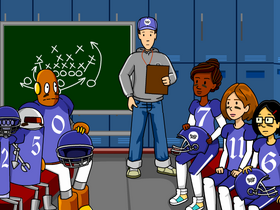| Football | |||
|---|---|---|---|
 Original version  Updated version | |||
| Airdate | November 3, 2007
Update: 2019 | ||
| Curriculum | Health Social Studies | ||
Football launched in Health/Social Studies November 3, 2007.
Summary[]
Tim discusses about football.
Appearances[]
- Tim (as the football coach)
- Moby (as Hi c ham "Zero" Zero u a l i)
- Cassie (as player 11)
- Rita (as player 6)
- Gary (as player 7) (old)
- Little Jimmy (as midget player)
- Bruiser (as player 2)
- Crusher (as player 5)
- Nat (as player 7) (remake)
Transcript[]
Quiz[]
- Football/Quiz
FYIs[]
Did You Know?[]

The Super Bowl, which is played every year in late January or early February, is a lot more than the National Football League’s championship game. It’s also the most-watched television event of the year (in 2012, more than 110 million people tuned in); a showcase for cutting-edge advertisements (a 30-second ad in the Super Bowl costs as much as $2.6 million); and a venue for the top musical acts in the world. With Super Bowl Sunday becoming something like a public holiday in the United States, it’s hard to believe that it didn’t exist until 1967.
The National Football League has been around since the 1920s, but during the 1960s, it faced serious competition from a new league, the American Football League. The two leagues went to war, with teams stealing each others’ established players and outbidding each other for new players. This war proved very costly, so the NFL and AFL made a peace agreement.
First, it was decided that the best team from the NFL would meet the best team in the AFL each year in a championship game. A few years later, the leagues merged into one united NFL, with the AFL teams becoming part of the new American Football Conference, and the original NFL teams joining the National Football Conference.
The first AFL-NFL Championship Game was played in Los Angeles in January 1967, but the name “Super Bowl” wasn’t used until 1971. It was coined by Kansas City Chiefs owner Lamar Hunt, who was inspired by watching his kids play with a bouncy rubber toy called a Super Ball.
Arts And Entertainment[]

Wanna learn more about football culture? Check out one of these films!
Rudy (1993): Sean Astin (pictured) stars as Daniel “Rudy” Ruettiger, a kid who overcomes enormous odds to realize his dream of playing football at Notre Dame University.
Remember the Titans (2000): In Virginia in 1970, a school district is integrated, forcing black and white students to play together for the first time.
Brian’s Song (1971): Brian Piccolo (played by James Caan) and Gale Sayers (played by Billy Dee Williams) are both Chicago Bears running backs during the 1960s. When Piccolo becomes ill with cancer, Sayers helps him through his ordeal.
Knute Rockne, All-American (1940): Tells the story of Rockne, the Notre Dame coach who became one of the most important figures in the history of football.
Friday Night Lights (2004): In a small town in Texas, people place great importance on the local high school football team. The film portrays both the coach and his players as under tremendous pressure to make it to the state championship.
Around The World[]

In most of the world, “football” refers to the game that Americans call soccer. But soccer and American football aren’t the only football games in the world. Here are some others.
Australian rules football (pictured): Played by two teams of eighteen players each on an oval field. Players use both hands and feet to pass and kick the ball downfield, in an effort to kick the ball between the opponents’ goal posts.
Canadian football: Similar to American football, but the field is 110 yards long instead of 100, there are 12 players per side instead of 11, and there are three downs instead of four.
Arena football: Designed to be played indoors, arena football is an odd combination of football, hockey, and soccer. The 50-yard field is enclosed by padded walls, so players can’t go out of bounds. The goalposts are narrower and have nets next to them, allowing missed kicks to rebound into the field of play. Punting is illegal. Scores are very high.
Six-, seven-, and nine-man football: In the American West, many high schools are too small to support a traditional eleven-player team. As a result, some schools have adopted versions of football that feature fewer players per team. The rules are similar, but field goals are worth four points instead of three.
Etc.[]

Football is an exciting game . . . but it’s the rivalries that make it really interesting. Here are some of the most important rivalries in college football!
Harvard vs. Yale: The oldest rivalry in college football, known simply as “The Game,” has been played every year since 1875.
University of Alabama vs. Auburn University: These are the two biggest schools in the state of Alabama, and they’ve been playing the “Iron Bowl” since 1893. Their annual match-up determines which side gets to “own” the state for a year.
Army vs. Navy: Every year since 1890, the cadets at the United States Military Academy in West Point, NY, take on the midshipmen of the United States Naval Academy of Annapolis, MD.
University of Michigan vs. Ohio State University: These two large Midwestern schools usually end up with the two best records in the Big Ten Conference—meaning that when they play each other at the end of every season, a championship is often on the line.
Notre Dame University vs. the University of Southern California: Notre Dame has had one of the nation’s most popular football teams for over a century. USC has pumped out some of the game’s all-time greats, including Reggie Bush, Frank Gifford, and Marcus Allen. Their meeting at the end of every year is something that all college football fans look forward to.
Way Back When[]

People have been playing football-type games for a long time. But official rules weren’t codified until England in the mid-19th century, when the rules for both soccer (in which players can’t touch the ball with their hands) and rugby (in which players could pick up the ball and run with it) were written down.
In America, the first set of football rules was drafted by representatives from four East Coast colleges—and they were soccer-style rules. But in 1874, a team from Harvard University played a rugby match against McGill University of Montreal, Quebec. The Harvard players loved the rough-and-tumble action, and introduced it to Yale University’s football team in 1875. It was a hit!
So the committee in charge of the rules began changing them to reflect the popularity of the rugby-style game. A Yale football star named Walter Camp (pictured) was instrumental in these changes, introducing concepts like the line of scrimmage, the snap from the center to the quarterback, and the “down” system. By 1900, the game was catching on nationwide, and 43 colleges fielded football teams.
Unfortunately, as it grew in popularity, it grew increasingly violent. In 1905, 19 American students died playing football, and dozens more were maimed. In response, President Theodore Roosevelt threatened to ban the game unless changes were made. So change it did.
For one thing, a dangerous formation called the “flying wedge” was outlawed, and the forward pass was legalized. Over the next century, the game changed at a more gradual pace until it became the sport that millions watch and play today.
In Depth[]

Unlike pretty much every other collegiate or professional sport, Division I college football doesn’t have a playoff system or tournament to determine a national champion. Instead, it has the Bowl Championship Series (BCS), one of the most complicated statistical systems you may ever come across.
At the end of the college season, there are five bowl games (postseason games usually played on or around New Year’s Day) designated “BCS Bowl Games.” One of these games is the National Championship Game, which pits the team ranked #1 in the country against the team ranked #2.
The other four games match up eight other highly-ranked teams from 11 Division I-A football conferences (Division I-A schools have the best football programs in the country). Teams that have won their conference championships often—but not always—make it in, since some conferences receive automatic bowl bids and some don’t.
So how does the BCS ranking system work? Well, it’s a compilation of three separate factors:
- The USA Today Coaches Poll is compiled by a board of 63 Division I-A football coaches.
- The Harris Interactive National College Football Poll is compiled by a panel of 114 former coaches, student-athletes, administrators and media representatives.
- And the third component averages the output of six different computerized ranking systems from across the country.
Teams are evaluated on a number of factors, including how many points they beat their opponents by and how talented their opponents are.
Make sense? That’s okay—no one else really understands how the BCS ranks teams, either!
FYI Comic[]

